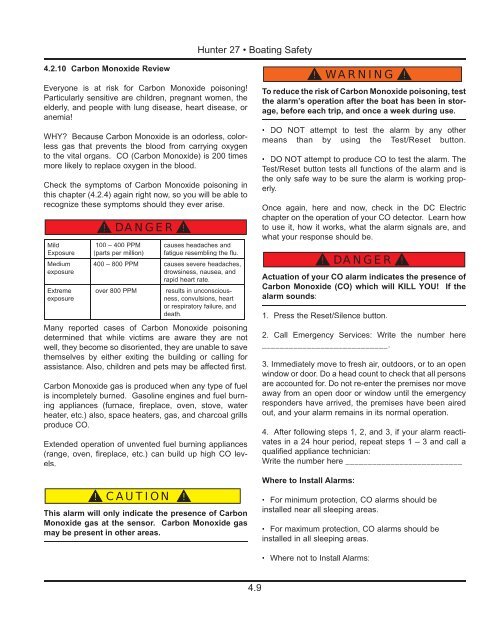27 Operator's Manual.. - Marlow-Hunter, LLC
27 Operator's Manual.. - Marlow-Hunter, LLC
27 Operator's Manual.. - Marlow-Hunter, LLC
You also want an ePaper? Increase the reach of your titles
YUMPU automatically turns print PDFs into web optimized ePapers that Google loves.
<strong>Hunter</strong> <strong>27</strong> • Boating Safety<br />
4.2.10 Carbon Monoxide Review<br />
Everyone is at risk for Carbon Monoxide poisoning!<br />
Particularly sensitive are children, pregnant women, the<br />
elderly, and people with lung disease, heart disease, or<br />
anemia!<br />
WHY? Because Carbon Monoxide is an odorless, colorless<br />
gas that prevents the blood from carrying oxygen<br />
to the vital organs. CO (Carbon Monoxide) is 200 times<br />
more likely to replace oxygen in the blood.<br />
Check the symptoms of Carbon Monoxide poisoning in<br />
this chapter (4.2.4) again right now, so you will be able to<br />
recognize these symptoms should they ever arise.<br />
Mild<br />
Exposure<br />
Medium<br />
exposure<br />
Extreme<br />
exposure<br />
! DANGER !<br />
100 – 400 PPM<br />
(parts per million)<br />
causes headaches and<br />
fatigue resembling the flu.<br />
400 – 800 PPM causes severe headaches,<br />
drowsiness, nausea, and<br />
rapid heart rate.<br />
over 800 PPM results in unconsciousness,<br />
convulsions, heart<br />
or respiratory failure, and<br />
death.<br />
Many reported cases of Carbon Monoxide poisoning<br />
determined that while victims are aware they are not<br />
well, they become so disoriented, they are unable to save<br />
themselves by either exiting the building or calling for<br />
assistance. Also, children and pets may be affected first.<br />
Carbon Monoxide gas is produced when any type of fuel<br />
is incompletely burned. Gasoline engines and fuel burning<br />
appliances (furnace, fireplace, oven, stove, water<br />
heater, etc.) also, space heaters, gas, and charcoal grills<br />
produce CO.<br />
Extended operation of unvented fuel burning appliances<br />
(range, oven, fireplace, etc.) can build up high CO levels.<br />
! CAUTION !<br />
This alarm will only indicate the presence of Carbon<br />
Monoxide gas at the sensor. Carbon Monoxide gas<br />
may be present in other areas.<br />
! WARNING !<br />
To reduce the risk of Carbon Monoxide poisoning, test<br />
the alarm’s operation after the boat has been in storage,<br />
before each trip, and once a week during use.<br />
• DO NOT attempt to test the alarm by any other<br />
means than by using the Test/Reset button.<br />
• DO NOT attempt to produce CO to test the alarm. The<br />
Test/Reset button tests all functions of the alarm and is<br />
the only safe way to be sure the alarm is working properly.<br />
Once again, here and now, check in the DC Electric<br />
chapter on the operation of your CO detector. Learn how<br />
to use it, how it works, what the alarm signals are, and<br />
what your response should be.<br />
! DANGER !<br />
Actuation of your CO alarm indicates the presence of<br />
Carbon Monoxide (CO) which will KILL YOU! If the<br />
alarm sounds:<br />
1. Press the Reset/Silence button.<br />
2. Call Emergency Services: Write the number here<br />
____________________________.<br />
3. Immediately move to fresh air, outdoors, or to an open<br />
window or door. Do a head count to check that all persons<br />
are accounted for. Do not re-enter the premises nor move<br />
away from an open door or window until the emergency<br />
responders have arrived, the premises have been aired<br />
out, and your alarm remains in its normal operation.<br />
4. After following steps 1, 2, and 3, if your alarm reactivates<br />
in a 24 hour period, repeat steps 1 – 3 and call a<br />
qualified appliance technician:<br />
Write the number here __________________________<br />
Where to Install Alarms:<br />
• For minimum protection, CO alarms should be<br />
installed near all sleeping areas.<br />
• For maximum protection, CO alarms should be<br />
installed in all sleeping areas.<br />
• Where not to Install Alarms:<br />
4.9

















